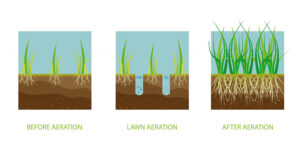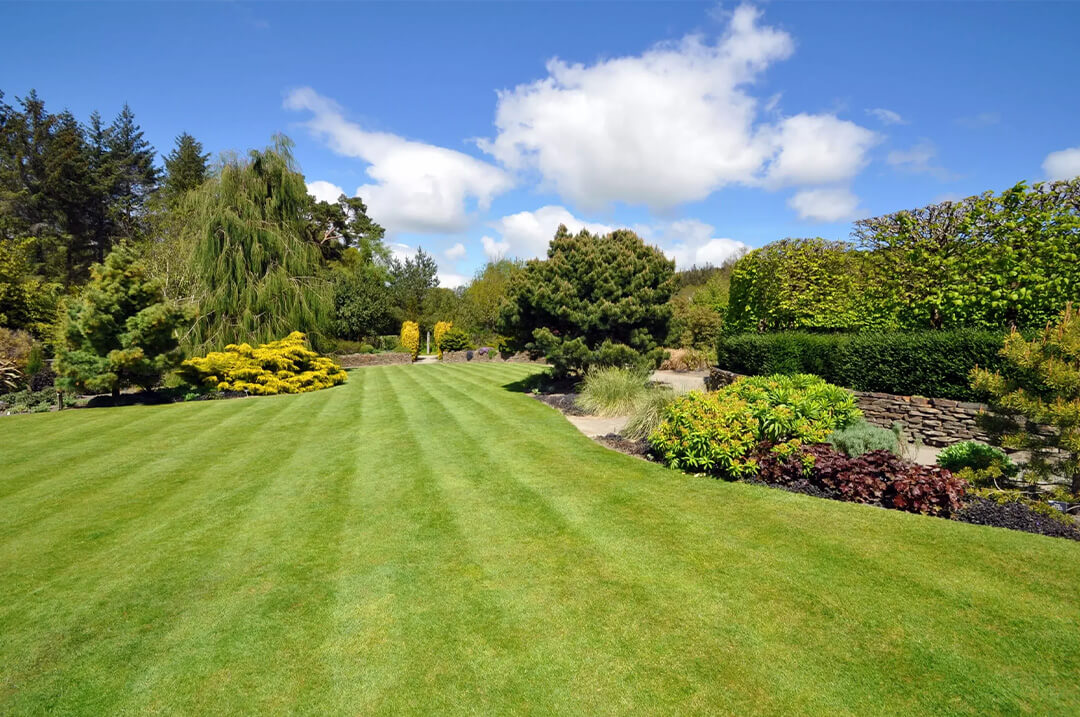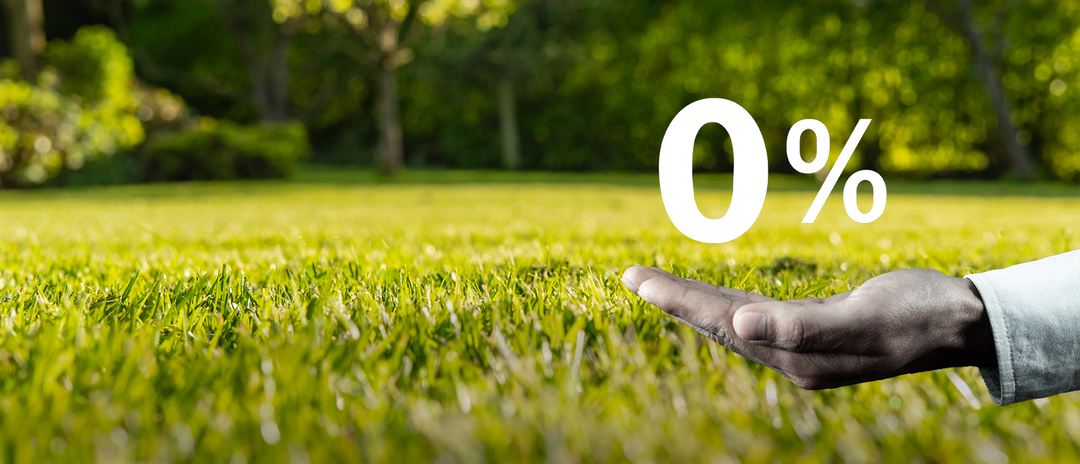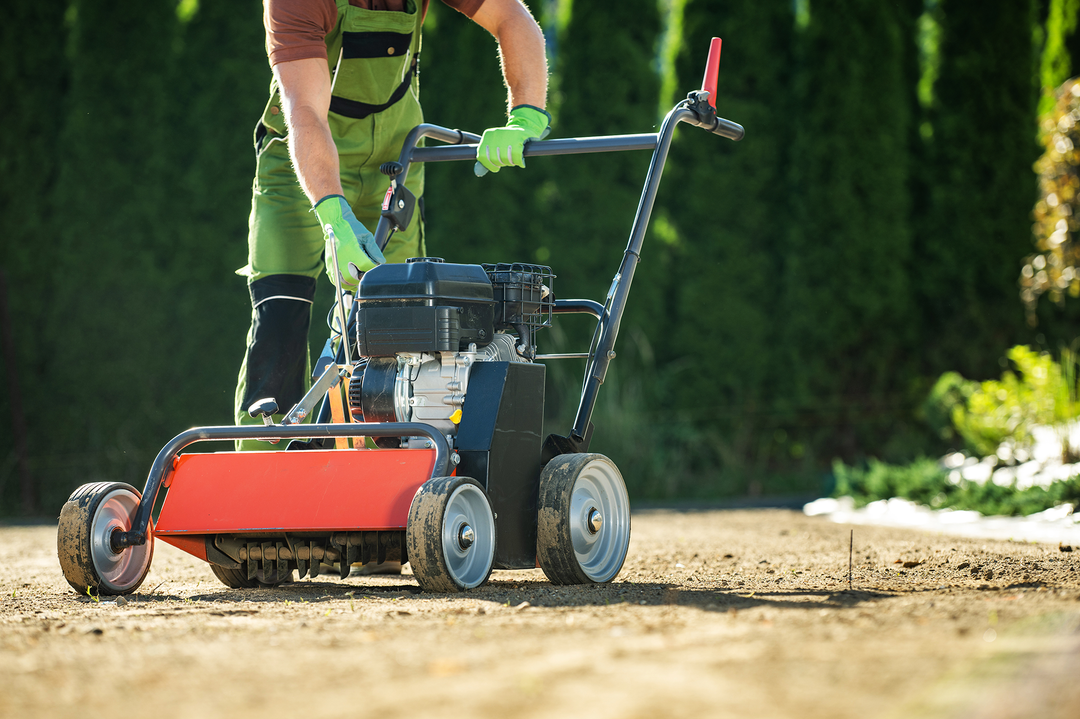Do I need to aerate my lawn? Not always, but sometimes it can be a big help. Imagine stepping out to a lush, vibrant lawn that's the envy of the neighbourhood. This can be your reality with the simple yet profound practice of lawn aeration. Lawn aeration is a critical component of lawn care that ensures the health and beauty of your grass by addressing soil compacity and promoting the free flow of air, water, and nutrients.
Understandably, to the untrained eye, your lawn may simply look like a plot of grass, but beneath the surface lies a complex ecosystem where the roots of your turf battle against soil compaction. Aeration breathes life into this hidden battlefield, providing a path for essentials to reach the roots and invigorate your lawn.
As we delve into "The Ultimate Guide to Lawn Aeration: Tips and Tricks for a Healthy Lawn," we will explore why aeration is central to lawn vitality, when the best time is to aerate, and how to achieve the best results. We'll guide you through the aeration process step by providing aftercare and maintenance tips for prolonged lawn health. Prepare to become the master of your verdant domain with the knowledge that follows.
Why is Lawn Aeration Important?
A lush, vibrant lawn is the hallmark of a well-maintained yard. But achieving that picturesque green space involves much more than regular watering and mowing. One crucial aspect of lawn care that is often overlooked is the process of aeration. This method directly addresses an unseen problem that can hinder the health of your turf: soil compaction. Compaction occurs when the particles in the soil are pressed tightly together, reducing the space between them. This compaction can severely limit the flow of nutrients, water, and oxygen to the grass roots, preventing them from establishing a robust and healthy growth pattern. By aerating your lawn, you effectively break through this compaction, enhancing the root system and revitalising your lawn's health and appearance.
Understanding Soil Compaction and Its Impact on Lawn Health
The foundational health of any lawn begins beneath the surface, within the unseen environment of the grass roots. With time and activity, especially in areas of heavy foot traffic or with heavy clay soils, lawns can suffer from soil compaction. This dense layer restricts the flow of essential elements such as oxygen, water, and nutrients, which grass roots need to thrive. The symptoms of compacted soil may not always be immediately apparent, but indicators include poor drainage, leading to water logging, and difficulty in maintaining a lush green appearance. The resilience of a lawn is also compromised as reduced root growth leaves it vulnerable to various stresses, such as heat waves and drought conditions. Regular aeration can suffice to alleviate these issues and is particularly vital for lawns with clay soils or where there is frequent foot traffic.
The Benefits of Aerating Your Lawn

The advantages of lawn aeration are numerous and contribute significantly to the vitality of your lawn. Below are some key benefits:
- Nutrient Uptake Enhancement: Aerating your lawn creates pathways for air, water, and nutrients to reach the root zone where they are most needed. This process enriches the roots and encourages healthier grass growth.
- Improved Water Absorption: Post aeration, soil is better able to absorb and retain water, reducing the problems of runoff and puddling.
- Water Conservation: Aerated lawns use water more efficiently, meaning they require less frequent watering, thus conserving water and reducing your irrigation bill.
- Root Growth: Compacted soil impairs root development; aeration facilitates deeper and stronger root growth, which is integral to the health and resilience of your lawn.
- Heat and Drought Resistance: With improved root systems and better water retention, your lawn is better prepared to endure the stresses of heat waves and drought periods.
In summary, aeration is not just a beneficial lawn care technique, but a necessary one for maintaining a strong, vibrant, and healthy lawn. Investing time in aeration can save a lot of effort in lawn maintenance in the long run while ensuring that your grass remains resilient against environmental stresses.
When to Aerate Your Lawn
Finding the right time to aerate your lawn is critical in optimising the health and appearance of your grass. Ideally, the perfect time to aerate is during the lawn's growing season, either in late spring or during the autumn months. This timing allows your grass to heal and fill in any open areas after the aeration process, ensuring a lush and robust lawn. It is advised to avoid aerating during the peak summer heat, as the added stress can challenge your lawn's ability to recover.
Considerations Based on Soil Type
Different soil types may necessitate varying aeration schedules. Heavy clay soil, known for its tendency to compact easily, often requires more frequent aeration to alleviate issues that affect water and nutrient absorption. In such cases, core aeration, which removes plugs of soil, is the preferred method as it effectively combats compaction and promotes essential elements reaching the roots. On the other hand, sandy or loamy soils are less prone to compaction and may benefit from less frequent aeration, typically every other year.
Identifying Signs of Soil Compaction
Recognizing the signs of soil compaction is imperative to maintaining a healthy lawn. Compacted soil can manifest itself through pooled water on the surface, shallow grass roots, slow growth, reduced tillering, yellowing of leaf blades, and a general thinning out of the grass. The appearance of certain weeds, such as ribwort plantain or daisies, can also be an indicator of compacted soil. Physically, compacted soil may feel hard to the touch, and it may cause the lawn to feel spongy and dry out quickly. If water puddles rather than being absorbed during rainstorms or if the grass is withering and losing its vibrant color, it's likely time to consider aeration.
Determining the Best Time for Aeration Based on Grass Growth
The type of grass you have also influences the best time to aerate. Cool-season grasses are best aerated in early fall or early spring, coinciding with their most active growth phase. For warm-season grasses, late spring or early summer, right before they enter their peak growing season, is the opportune time. Aerating while the grass is actively growing ensures quick recovery. Autumn aeration is particularly beneficial as it combines active grass growth, lower temperatures, less weed competition, and the upcoming rest period during winter, allowing your grass to recuperate and strengthen. Remember though, aeration is not recommended during the winter when grass is dormant nor immediately after prolonged periods of cold or wet weather that can hinder grass recovery.
Methods of Lawn Aeration
A healthy lawn not only beautifies your home but also benefits the environment. However, soil compaction can prevent grass roots from absorbing necessary air, water, and nutrients. To mitigate this, aeration is a crucial step in lawn care. There are several methods available, each suited to different conditions and requiring varied levels of effort.
Core Aeration: An Effective and Common Method
When dealing with compacted soil, especially those that are heavy in clay, core aeration is considered the most effective aeration method. Core aerators are equipped with hollow tines that are mechanically driven into the lawn, removing small plugs of soil typically 2 to 4 inches deep and about 0.5 to 0.75 inches in diameter. These plugs are usually extracted at intervals of 2 to 3 inches apart. By doing this, core aeration not only immediately alleviates compaction but also facilitates the delivery of air, fertiliser, and water to the roots, promoting a healthier lawn.
Plug Aerators: Enhancing Aeration with Soil Plugs
Plug aerators operate on a similar principle to core aerators, utilising hollow tines to remove plugs of soil and leaving holes in your lawn. Lawn care professionals often prefer this method as it results in deeper, more beneficial changes to soil structure. The plugs left atop the lawn by plug aerators decompose gradually, returning nutrients to the ecosystem. This method not only improves the influx of vital elements to the grass roots but also avoids further compaction of the soil around the holes, which can be a risk with other aeration techniques.
Spike Aerators: A Quick and Easy Alternative
For those with sandy or loamy soils, or smaller lawn areas, spike aerators might be a suitable choice. These tools operate by punching holes into the soil with spikes, rather than removing plugs of soil. Spike aerators are less labor-intensive than plug aerators and provide a simple solution for homeowners to increase air exchange within the soil. However, they may not be suitable for all soil types, particularly heavy clay soils, as they can potentially create more compaction around the holes.
Hollow Tines vs. Garden Fork: Choosing the Right Tool for Your Lawn
When it comes to manual aeration options, choosing between a hollow tine aerator and a garden fork depends on your lawn size and the severity of compaction. Hollow tine aerators extract soil cores efficiently for deep aeration and are ideal for lawns with severe compaction. Garden forks, meanwhile, can be manually pushed and wriggled into the turf to break up compacted soil. They are often recommended for smaller or lightly compacted lawn areas. While both tools address compaction issues, hollow tines specialise in removing soil cores to optimise root zone conditions for a more resilient and healthy lawn growth.
In conclusion, selecting the suitable aeration method hinges on your lawn’s specific condition, soil type, and size. While power-driven aerators like core and plug aerators offer a thorough solution against compaction, simpler tools like spike aerators and garden forks provide flexibility to homeowners who prefer a more hands-on approach for smaller tasks.
How to Prepare Your Lawn for Aeration
Preparing your lawn for aeration is a critical step in ensuring that the aeration process is as effective as possible. The goal is to create optimal conditions where the aeration equipment can reach the soil and roots effectively, enabling your lawn to reap the full benefits of this important lawn care practice.
Clearing the Lawn of Debris and Dead Grass
A thicker thatch layer, which is a buildup of dead organic matter such as leaves and grass clippings, can be detrimental to your lawn's health. It obstructs light, water, and nutrient absorption, which can lead to a less vibrant and resilient turf.
Aeration plays a critical role in thatch management. By reducing soil compaction through aeration, you enhance the lawn's drainage and encourage microbial activity, which in turn helps decompose thatch. Core aeration, in particular, removes small plugs of soil from your lawn, which not only improves oxygen, nutrient, and water penetration but can also alleviate much of the thatch problem.
Before aerating, remove large pieces of debris and dead grass. This simplifies the process and ensures that the lawn is well-prepared for the aeration equipment, allowing it to operate at maximum efficiency without blockages.
Ensuring Proper Watering Before Aeration
Ensuring the soil is adequately moist before aeration is essential. An easy rule of thumb is to aerate the day following a rain shower, or alternatively, water the lawn yourself the day before aeration. The soil should be damp but not soaked, which makes it easier for the aeration machine to penetrate and effectively relieve compaction.
A well-watered lawn ensures a softer ground, giving you a better chance of removing more significant soil plugs and achieving greater depth with each aeration pass. However, be careful not to overwater, as this can make the ground too muddy and potentially hinder the aeration equipment.
It's also crucial to mark any sprinkler heads or shallow utility lines you may have in your yard. This helps prevent damaging these structures during aeration, saving you from the headache of repairs. By following these preparation steps, you set the stage for a smooth aeration process and pave the way towards a healthier, more vibrant lawn.
The Aeration Process Step by Step
Lawn aeration is a pivotal practice offering a breath of fresh air to your hardworking turf. This task might seem daunting at first, but fear not—we'll walk you through it step by step. By allowing air, water, and vital nutrients to reach the roots, we combat soil compaction, a notorious barrier to a healthy lawn.
Step 1: Marking Sprinkler Heads and Other Obstacles
Prior to unleashing your aerator on the lawn, embark on a treasure hunt of sorts—flagging sprinkler heads, shallow utility lines, or other subsurface impediments. A kiss between an aerator and a sprinkler head or an electrical line is no love story; it's a prelude to an unplanned and often expensive repair. Carefully mapping and marking these hidden dangers is crucial. Sprinkler heads tend to lurk right below the terrain's crest, vulnerable to the aerator's advances. Tag each with a small flag or a visible marker to avoid any undesirable encounters. Accidents can lead to service disruptions or, worse, safety hazards. The extra minutes spent on this task could save you not just money but peace of mayhem-free mind.
If aerating a lawn in the shade, watch out for tree roots as these can easily be damaged and can damage aeration machinery.
Step 2: Adjusting Aeration Depth for Soil Type
Aeration depth is not a "one size fits all" affair. The golden rule with core or plug aerators is to aim for 2 to 3 inches, deep enough to bypass that tenacious thatch layer, yet not so aggressive as to traumatise your turf. This kind of precision encourages a deeper root system and fosters a resilient, lush lawn. Remember, different soil types may warrant subtle adjustments to this guideline. For example, clay soil, more prone to compaction, might benefit from these full 3 inches, while a lighter soil may not need quite as much. Adjust your aerator accordingly, and remember, this step isn't about depth alone—it's about promoting a habitat where your grass can flourish.
Step 3: Performing Core Aeration or Using Plug/Spike Aerators
Now comes the action—core aeration vs. plug or spike aeration. If you're pursuing the core aeration route, you'll be removing small cylinders of dirt, allowing for de-compaction and room for expansion. Precisely-spaced holes every 8-10 cm maximise the benefit. Some situations call for a double pass, especially in heavily compacted areas. For smaller yards or those minimalists among us, spike aerators or even aerator shoes might do the trick. However, beware—the delight of simplicity may be offset by increased soil pressure, potentially raising compaction woes.
For larger lawns with formidable compaction, core or plug aerators are the professionals' choice. These machines professionally extract soil plugs, ensuring your turf's access to the essentials—air, water, nutrients—are unhampered. Post-aeration, those holes left in your lawn are not for naught. They're the foundation of a thriving sod, where roots run deep, and grass blades reach high—healthy, robust, and evergreen.
Aftercare and Maintenance
After your lawn has undergone the invigorating process of aeration, it enters a phase of recovery and revitalisation. To bolster this progress, aftercare and maintenance are not merely recommendations—they're imperative. Once the soil has been loosened and plugs have been removed, the next step is to nurture this newfound openness with the right amounts of nutrients and care. If applying grass seed, consider covering with a layer of soil.
Post-Aeration Fertilising and Top Dressing Directly following aeration, seize the opportunity to fertilise. This allows the nutrients to dive deep into the soil, reaching the grass roots more effectively than they would have pre-aeration, thus promoting vigorous growth. A top dressing of soil or compost can further enhance this renewal by smoothing out the lawn and filling in the holes, making for an even spread of organic matter. Covering any seed with a thin layer of soil will help with germination.
Routine Lawn Care Maintain your usual mowing and watering schedule, ensuring that you’re not cutting the grass too short—this can stress the newly aerated lawn. Instead, aim for a height that supports healthy grass and deep roots. Watering should be light yet frequent in the days following aeration, particularly if you’ve overseeded. This keeps the seeds from drying out and encourages germination, allowing your lawn to become dense, lush, and beautifully green.
Irrigation Schedule Strive for about an inch of water per week, keeping in mind rainwater contribution. This level of hydration should prevent your lawn from drying out without over-saturating it. Keep the soil moist but not overly wet. If the surface gets too wet it can encourage turf diseases like furarium patch.
Dealing with the Thatch Layer After Aeration
The thatch layer—the intertwined mat of roots, stems, and leaves—can be your lawn’s worst enemy if it becomes too thick. Not only does it create a barrier to essential nutrients, but it also restricts water and air circulation. Aeration can help reduce or even prepare the thatch layer for more specialised dethatching treatments.
Breaking Down Thatch Post-Aeration With aeration complete, it’s the perfect moment to break down any remaining thatch. Specialised products can assist in its decomposition, whereas natural processes are also encouraged by the improved soil conditions.
Thatch Thickness Check In case your thatachable culprit exceeds 1/2 inch in thickness, you'll want to perform dethatching to reduce this layer, complementing the aeration process and ensuring your grass gets all the nutrients it craves.
Seeding and Fertilising for Optimal Results
In the aftermath of aeration, seeding and fertilising your lawn can yield tremendous benefits. Indeed, aeration has set the stage for optimal seed-to-soil contact and nutrient absorption.
Soil Amendments When appropriate, use lime to alleviate acidic soil conditions or gypsum to break down heavy clay soils. Each amendment aids the soil in achieving its ideal structure and pH balance—a crucial factor for robust grass growth.
Seed and Fertilise Promptly apply grass seed and fertilise the lawn after aeration. This ensures that your seeds have the best chance to germinate, and the fertiliser can penetrate deeply, reaching the roots where it’s most needed. Remember to pick a seed blend suitable for your lawn's specific conditions, be it sun exposure or foot traffic.
Regular Watering and Mowing Practices
Following aeration, maintain a regular watering and mowing regimen tailored to aiding your lawn's recovery.
Watering Routine Keep the soil moderately moist by watering every two to three days, particularly after overseeding. This consistent schedule helps seeds to sprout and roots to grow deep, fortifying your turf for the future.
Scheduled Mowing Do not neglect your mowing routine; a freshly aerated lawn still needs to be trimmed regularly. However, ensure that blades are sharp and mowing is done at a consistent and appropriate height to prevent undue stress on the grass.
By adhering to these aftercare strategies, your lawn will not only recover from aeration but will also leap towards greater health and vitality, ready to showcase its lushness.














